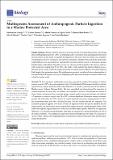Por favor, use este identificador para citar o enlazar a este item:
http://hdl.handle.net/10261/317362COMPARTIR / EXPORTAR:
 SHARE SHARE
 CORE
BASE CORE
BASE
|
|
| Visualizar otros formatos: MARC | Dublin Core | RDF | ORE | MODS | METS | DIDL | DATACITE | |

| Título: | Multispecies Assessment of Anthropogenic Particle Ingestion in a Marine Protected Area |
Autor: | Compa, Montserrat; Alomar, Carme; López-Cortès, María Francesca; Ríos-Fuster, Beatriz; Morato, Mercé; Fagiano, Valentina; Deudero, Salud CSIC ORCID | Palabras clave: | Centro Oceanográfico de Baleares Medio Marino |
Fecha de publicación: | 20-sep-2022 | Citación: | Biology, 11. 2022: 13-75 | Resumen: | We have applied a multispecies ecosystem approach to analyse the ingestion of anthropogenic particles (AP) in the gastrointestinal tract of 313 individuals (17 fish species and 8 invertebrate species) from pelagic, demersal and benthic habitats in a marine protected area off the Western Mediterranean (Cabrera National Park). We have quantified and characterized the ingestion at several taxonomic levels of fish, sea urchins, sea cucumbers, bivalves, and jellyfish in relation to biotic/abiotic factors based on taxonomic groups, trophic guilds (functional groups) and habitats. AP ingestion occurrence ranged from 26 to 100% with no significant differences among taxonomic groups. The fish within the MPA showed an overall ingestion occurrence ranging from 0 to 100%, the echinoderms from 29 to 100%, the bivalves from 72 to 96% and the jellyfish 36% ingestion. The ecosystem approach applied to evaluate overall AP ingestion within the species reported that for trophic guilds, the omnivorous species ingested the highest amounts of anthropogenic items, while herbivores ingested significantly fewer items than all other trophic guilds. Moreover, no significant differences were found amongst habitats, indicating a homogeneous spatial distribution of APs at all studied habitats. The multispecies approach provided insight into the high APs exposure to species within Cabrera MPA, highlighting the potential harm linked with marine litter that threatens marine biodiversity. | URI: | http://hdl.handle.net/10261/317362 | DOI: | https://doi.org/10.3390/biology11101375 | ISSN: | 1074-5521 |
| Aparece en las colecciones: | (IEO) Artículos |
Ficheros en este ítem:
| Fichero | Descripción | Tamaño | Formato | |
|---|---|---|---|---|
| 2022_Compa et al_Biota Cabrera.pdf | Artículo | 2,66 MB | Adobe PDF |  Visualizar/Abrir |
CORE Recommender
Page view(s)
15
checked on 16-may-2024
Download(s)
22
checked on 16-may-2024
Google ScholarTM
Check
Altmetric
Altmetric
NOTA: Los ítems de Digital.CSIC están protegidos por copyright, con todos los derechos reservados, a menos que se indique lo contrario.
